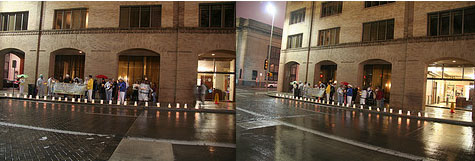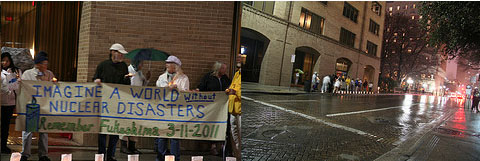Call for an end to nuclear power in San Antonio, Reactor safety and concerned scientists, CPS Energy plans and public opinion
MARCH 14, 2012
The QueQue
San Antonio Current
Call for an end to nuclear power in San Antonio


It was a dank, dark, drizzly Luminaria-less night, but a dozen-plus protestors trudged past the Federal Building downtown Saturday night with a banner calling on the few squinting drivers and umbrellaed pedestrians to "Imagine a World Without Nuclear Disasters." They walked down César Chávez Boulevard before hanging a right on Navarro Street to take up a position on the sidewalk outside CPS Energy‘s offices. Every few minutes someone tried to get a chant going, "Sayonara nuclear power" being the clunker in the bunch, and members of Energía Mía lit candles to place on the curb in memory of not only the thousands that died following the 9-magnitude earthquake and resulting tsunami in Japan a year ago, but for the victims likely still to come from the radioactive contamination wrought by the triple meltdown and hydrogen explosions at the Daiichi nuclear complex at Fukushima. "I would like to see us go to a zero nuclear power position," said a bearded Allen Townsend, who has tracked energy issues since the 1970s. "My big concern is the waste. Some of that waste is like a 20,000-year half-life, and I don’t think we can take care of something that long. That’s mortgaging the future."
Former City Councilmember Maria Berriozábal, the lone council opponent to STP 1 and 2 when they were constructed in the 1980s, said she hopes the units now being reviewed for license extensions that could have them operating until almost 2050 instead of shuttering in the late 2020s fail the test. "They’re old. They’re shut down as we speak because of problems. And we’ve seen all the problems that we’ve had in other cities," she said. "We should just concentrate all of our efforts on the good job that CPS is doing on sustainable energy and just quit nuclear energy." Lamenting the health risks that come from nuclear, former elementary teacher Helen Villarreal agreed, adding that the United States is losing an opportunity to be a leader in the field of low-polluting energy sources such as solar, wind, biomass, and geothermal.
Radioactive contamination from what may be the world’s worst nuclear disaster has blanketed the countryside around Fukushima and poured into the Sea of Japan, contaminating many domestic products and impacting the nation’s export business. Radioactive fallout was even tracked to cities in the United States. While regulators insist the minute levels of radioactive cesium and iodine, for instance, don’t pose a health risk here, two researchers publishing in the International Journal of Health Services found that 14,000 "excess" U.S. deaths – particularly among infants – may be linked the radioactive fallout from Fukushima. The gap represents the same sort of double-minded approach within the research community that still divides opinions about the Chernobyl nuclear disaster of 1986. An international collaboration of researchers have pinned the estimated fatalities linked to Chernobyl at 5,000 nearby and about 30,000 worldwide. However, reports filed by physicians in Ukraine and Russia published by the New York Academy of Sciences claim the death toll wrought by Chernobyl has already approached a million dead.
Reactor safety and concerned scientists
As some of the last reactors to go online in the U.S., STP also enjoys one of the stronger safety records in the fleet, said Buddy Eller, spokesperson for the STP Nuclear Operating Company. And if Fukushima Daiichi’s disaster was brought on by the loss of connection to the electrical grid from earthquake damage and backup generators swamped by the resulting tsunami – a double-whammy above and beyond what the reactors were built to sustain – Eller expressed confidence in STP’s three emergency safety systems that include "locomotive-sized" diesel generators in "flood-proof" concrete bunkers. Annual Assessment letters from the U.S. Nuclear Regulatory Commission for 2011 dated March 5, 2012, also give Texas nukes, the South Texas Project and Comanche Peak in North Texas, clean bills of health. "The NRC determined that overall, South Texas Project Electric Generating Station Units 1 and 2 operated in a manner that preserved public health and safety and met all cornerstone objectives."
But the Union of Concerned Scientists blasted the U.S. Nuclear Regulatory Commission in a report last week for failing to enact key recommendations from its own post-Fukushima assessment. "Many of its proposals to safeguard against such a calamity here are good in principle," the report states, "but their effectiveness will depend on how well they are implemented, and how quickly." High on their complaint is the NRC’s unfulfilled charge to clarify "patchwork" regulations for severe accidents (those exceeding the abilities of the plants to withstand, see Fukushima). In fact, such action, while highest on the NRC’s list of priorities, will be some of the last actions to be implemented, the UCS report states.
CPS Energy plans and public opinion
Plans to double the 1,080-megawatt nuclear-power complex in Matagorda County responsible for a full third of greater San Antonio’s power fell through after ballooning expenses in 2009 gave way to internal bickering and lawsuits between partners CPS, NRG Energy, and Toshiba in 2010, but members of Energía Mía want the city to fully divest itself from what they consider an "unforgiving" power source. It’s a non-starter at CPS, where an emailed response to questions on the subject reads simply: "CPS Energy has not evaluated elimination of nuclear from its energy portfolio and does not have any plans to do so." Whether STP 1 and 2 will be closed in 2028 or 2048, increased maintenance and repair will be the name of the game for years to come. Unit 2, for instance, has been offline for several months now as crews work to replace a rotor in the main generator, Eller said. Yet in order to fulfill its goal of 20 percent renewables by 2020 and a full 65 percent of its energy supply from "low-carbon" sources, CPS is pursuing non-nuclear and non-coal options vigorously. "Mothballing Deely in 2018 and acquiring a gas plant to replace Deely’s 870 MW along with wind, solar and clean coal is helping us get there," spokesperson Christine Patmon said. CPS announced this week that it is purchasing an 800-megawatt combined-cycle gas plant in Seguin. In January, a deal for 400 solar megawatts from OCI Solar was announced. How well the "bridge fuel" play on natural gas works out will hinge a lot on the environmental costs of shale gas development and the durability of formations like the Eagle Ford in South Texas (see "Inflated figures").
Meanwhile, a recent survey by ORC International performed Last month for the Civil Society Institute found that 57 percent of Americans (extrapolated from a survey of 1,032) are less supportive of nuclear power post-Fukushima. "This survey is another piece of bad news for new nuclear construction in the U.S.," said Peter Bradford, a former NRC commissioner and current adjunct law professor on nuclear power and public policy at Vermont Law School, said in a prepared release. "The nuclear industry has spent millions on polls telling the public how much the public longs for nuclear power. Such polls never ask the real world questions linking new reactors to rate increases or to accident risk. Fukushima has made the links to risk much clearer in the public’s mind."
This document contains copyrighted material whose use has not been specifically authorized by the copyright owner. SEED Coalition is making this article available in our efforts to advance understanding of ecological sustainability, human rights, economic democracy and social justice issues. We believe that this constitutes a "fair use" of the copyrighted material as provided for in section 107 of the US Copyright Law. If you wish to use this copyrighted material for purposes of your own that go beyond "fair use", you must obtain permission from the copyright owner.


